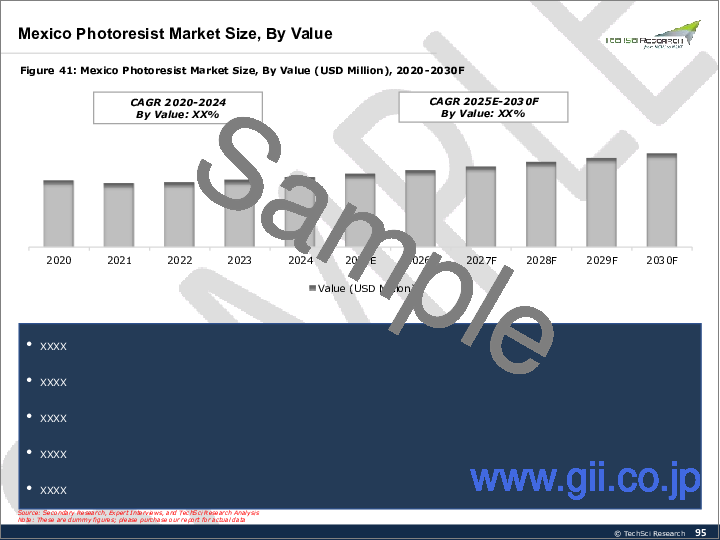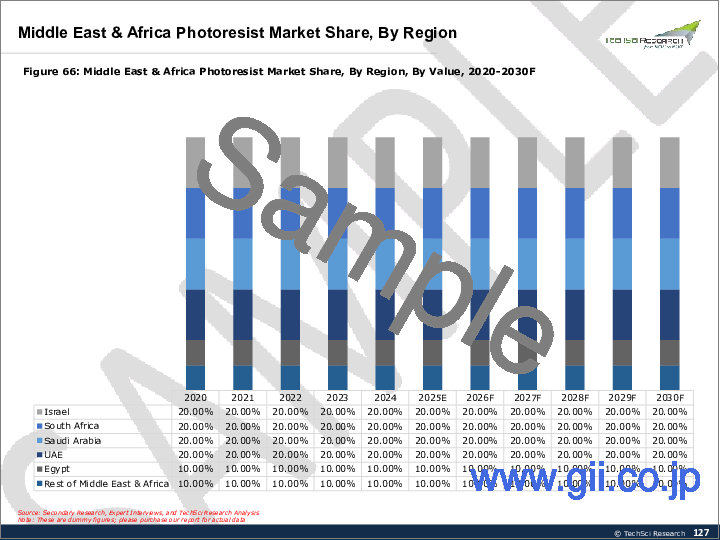|
|
市場調査レポート
商品コード
1771111
フォトレジスト市場- 世界の産業規模、シェア、動向、機会、予測、タイプ別、用途別、地域別、競合別、2020年~2030年Photoresist Market - Global Industry Size, Share, Trends, Opportunity, and Forecast, Segmented By Type, By Application, By Region and Competition, 2020-2030F |
||||||
カスタマイズ可能
|
|||||||
| フォトレジスト市場- 世界の産業規模、シェア、動向、機会、予測、タイプ別、用途別、地域別、競合別、2020年~2030年 |
|
出版日: 2025年07月14日
発行: TechSci Research
ページ情報: 英文 185 Pages
納期: 2~3営業日
|
全表示
- 概要
- 目次
フォトレジストの世界市場規模は2024年に37億6,000万米ドル、2030年には47億7,000万米ドルに達し、予測期間中のCAGRは4.26%で成長すると予測されています。
フォトレジストはリソグラフィ技術とともに、集積回路(IC)、MEMS、マイクロエレクトロニクス、マイクロ流体工学、データストレージ、バイオテクノロジーなど、幅広い先端アプリケーションの基盤技術となっています。リソグラフィーの分野では、特にポリマーをベースとした手法の利用が拡大しており、大きな技術革新が起きています。学術・産業両分野で最も広く使用されている技術には、光リソグラフィと電子ビーム(e-beam)リソグラフィがあります。微細加工プロセスにおけるフォトレジストの重要な役割は、半導体および電子機器製造における需要の増加とともに拡大し続けており、これは現代の技術生態系におけるフォトレジストの不可欠な位置を反映しています。
| 市場概要 | |
|---|---|
| 予測期間 | 2026年~2030年 |
| 市場規模:2024年 | 37億6,000万米ドル |
| 市場規模:2030年 | 47億7,000万米ドル |
| CAGR:2025年~2030年 | 4.26% |
| 急成長セグメント | ARF液浸フォトレジスト |
| 最大市場 | アジア太平洋 |
市場促進要因
MEMSとセンサー需要の増加
市場の課題
サプライチェーンの混乱
主要市場動向
持続可能性の重視の高まり
目次
第1章 概要
第2章 調査手法
第3章 エグゼクティブサマリー
第4章 世界のフォトレジスト市場展望
- 市場規模・予測
- 金額別
- 市場シェア・予測
- タイプ別(ARF液浸フォトレジスト、ARFドライフォトレジスト、KRFフォトレジスト、GラインおよびIラインフォトレジスト)
- 用途別(半導体・IC、LCD、プリント基板、その他)
- 地域別
- 企業別(2024年)
- 市場マップ
- タイプ別
- 用途別
- 地域別
第5章 アジア太平洋のフォトレジスト市場展望
- 市場規模・予測
- 金額別
- 市場シェア・予測
- タイプ別
- 用途別
- 国別
- アジア太平洋:国別分析
- 中国
- インド
- オーストラリア
- 日本
- 韓国
第6章 欧州のフォトレジスト市場展望
- 市場規模・予測
- 市場シェア・予測
- 欧州:国別分析
- フランス
- ドイツ
- スペイン
- イタリア
- 英国
第7章 北米のフォトレジスト市場展望
- 市場規模・予測
- 市場シェア・予測
- 北米:国別分析
- 米国
- メキシコ
- カナダ
第8章 南米のフォトレジスト市場展望
- 市場規模・予測
- 市場シェア・予測
- 南米:国別分析
- ブラジル
- アルゼンチン
- コロンビア
第9章 中東・アフリカのフォトレジスト市場展望
- 市場規模・予測
- 市場シェア・予測
- 中東・アフリカ:国別分析
- 南アフリカ
- サウジアラビア
- アラブ首長国連邦
第10章 市場力学
- 促進要因
- 課題
第11章 市場動向と発展
- 最近の動向
- 製品上市
- 合併と買収
第12章 世界のフォトレジスト市場:SWOT分析
第13章 ポーターのファイブフォース分析
- 業界内の競合
- 新規参入の可能性
- サプライヤーの力
- 顧客の力
- 代替品の脅威
第14章 競合情勢
- ALLRESIST GmbH
- Asahi Kasei Corporation
- DJ MicroLaminates, Inc.
- DuPont de Nemours Inc
- FUJIFILM Holdings America Corporation
- JSR Corporation.
- KOLON Industries, Inc
- Microchemicals GmbH
- Sumitomo Chemical Co., Ltd.
- Shin-Etsu Chemical Co., Ltd.
第15章 戦略的提言
第16章 調査会社について・免責事項
The Global Photoresist Market was valued at USD 3.76 Billion in 2024 and is projected to reach USD 4.77 Billion by 2030, growing at a CAGR of 4.26% during the forecast period. Photoresists, along with lithographic techniques, have become foundational technologies across a wide range of advanced applications, including integrated circuits (ICs), MEMS, microelectronics, microfluidics, data storage, and biotechnology. The lithography sector has seen substantial innovation, particularly with the growing use of polymer-based methods. Among the most widely used techniques in both academic and industrial domains are optical lithography and electron-beam (e-beam) lithography. The critical role of photoresists in microfabrication processes continues to expand as demand increases across semiconductor and electronics manufacturing, reflecting their indispensable place in modern technological ecosystems.
| Market Overview | |
|---|---|
| Forecast Period | 2026-2030 |
| Market Size 2024 | USD 3.76 Billion |
| Market Size 2030 | USD 4.77 Billion |
| CAGR 2025-2030 | 4.26% |
| Fastest Growing Segment | ARF Immersion Photoresist |
| Largest Market | Asia Pacific |
Key Market Drivers
Rise in Demand of MEMS and Sensors
Photoresists, as light-sensitive materials, are integral to the fabrication of Microelectromechanical Systems (MEMS) and sensors, serving a crucial role in various microfabrication techniques. For instance, India's Semi-Conductor Laboratory (SCL) is equipped to process 150-mm (6") silicon substrates, including advanced types like SOI wafers and high-resistivity silicon wafers. The facility operates with comprehensive CMOS-based fabrication processes, including lithography, deposition, etching, and ion implantation, all performed within a Class-10 cleanroom. These processes support the production of key components in sectors such as consumer electronics, automotive, industrial automation, and healthcare. As demand for compact, high-performance devices grows, the requirement for advanced photoresist materials in MEMS and sensor production is also accelerating.
Key Market Challenges
Disruptions in Supply Chain
Supply chain disruptions continue to pose a substantial challenge for the Global Photoresist Market. Since the onset of the pandemic, factory shutdowns, transport delays, and complex regulatory landscapes have severely affected production cycles. These obstacles are particularly impactful in the photoresist industry, where consistent material availability is essential to semiconductor and electronic device manufacturing.
The consequences of these disruptions go beyond the photoresist segment, affecting broader supply chains and exacerbating the ongoing semiconductor shortage. As photoresists are a critical element in chip manufacturing, any interruption in their supply directly impacts fabrication efficiency and the ability to meet rising global demand. Ensuring a stable and resilient supply chain is vital to maintaining competitiveness and supporting the overall electronics ecosystem.
Key Market Trends
Growing Emphasis on Sustainability
Sustainability is becoming a key trend in the Global Photoresist Market, fueled by stringent environmental regulations and rising pressure to adopt eco-friendly practices. Innovations such as water-based and bio-based photoresists are gaining traction for their biodegradability and reduced reliance on hazardous chemicals. These advancements align with the industry's shift toward greener manufacturing processes and global efforts to mitigate climate change.
The production of photoresists involves solvents, developers, and other chemicals that can pose environmental and health risks if not properly managed. With global regulatory bodies tightening rules around emissions and hazardous substances-including PFAS and VOCs-manufacturers are being compelled to reformulate materials and improve waste management practices. This shift not only supports environmental goals but also positions sustainable photoresist technologies as a competitive differentiator in the evolving market landscape.
Key Market Players
- ALLRESIST GmbH
- Asahi Kasei Corporation
- DJ MicroLaminates, Inc.
- DuPont de Nemours Inc
- FUJIFILM Holdings America Corporation
- JSR Corporation
- KOLON Industries, Inc
- Microchemicals GmbH
- Sumitomo Chemical Co., Ltd.
- Shin-Etsu Chemical Co., Ltd.
Report Scope:
In this report, the Global Photoresist Market has been segmented into the following categories, in addition to the industry trends which have also been detailed below:
Photoresist Market, By Type:
- ARF Immersion Photoresist
- ARF Dry Photoresist
- KRF Photoresist
- G-Line & I-Line Photoresist
Photoresist Market, By Application:
- Semiconductors & ICs
- LCDs
- Printed Circuit Boards
- Others
Photoresist Market, By Region:
- North America
- United States
- Canada
- Mexico
- Europe
- France
- United Kingdom
- Italy
- Germany
- Spain
- Asia Pacific
- China
- India
- Japan
- Australia
- South Korea
- South America
- Brazil
- Argentina
- Colombia
- Middle East & Africa
- South Africa
- Saudi Arabia
- UAE
Competitive Landscape
Company Profiles: Detailed analysis of the major companies present in the Global Photoresist Market.
Available Customizations:
Global Photoresist Market report with the given market data, TechSci Research offers customizations according to a company's specific needs. The following customization options are available for the report:
Company Information
- Detailed analysis and profiling of additional market players (up to five).
Table of Contents
1. Product Overview
- 1.1. Market Definition
- 1.2. Scope of the Market
- 1.2.1. Markets Covered
- 1.2.2. Years Considered for Study
- 1.2.3. Key Market Segmentations
2. Research Methodology
- 2.1. Objective of the Study
- 2.2. Baseline Methodology
- 2.3. Key Industry Partners
- 2.4. Major Association and Secondary Sources
- 2.5. Forecasting Methodology
- 2.6. Data Triangulation & Validation
- 2.7. Assumptions and Limitations
3. Executive Summary
- 3.1. Overview of the Market
- 3.2. Overview of Key Market Segmentations
- 3.3. Overview of Key Market Players
- 3.4. Overview of Key Regions/Countries
- 3.5. Overview of Market Drivers, Challenges, Trends
4. Global Photoresist Market Outlook
- 4.1. Market Size & Forecast
- 4.1.1. By Value
- 4.2. Market Share & Forecast
- 4.2.1. By Type (ARF Immersion Photoresist, ARF Dry Photoresist, KRF Photoresist, G-Line & I-Line Photoresist)
- 4.2.2. By Application (Semiconductors & ICs, LCDs, Printed Circuit Boards, Others)
- 4.2.3. By Region
- 4.2.4. By Company (2024)
- 4.3. Market Map
- 4.3.1. By Type
- 4.3.2. By Application
- 4.3.3. By Region
5. Asia Pacific Photoresist Market Outlook
- 5.1. Market Size & Forecast
- 5.1.1. By Value
- 5.2. Market Share & Forecast
- 5.2.1. By Type
- 5.2.2. By Application
- 5.2.3. By Country
- 5.3. Asia Pacific: Country Analysis
- 5.3.1. China Photoresist Market Outlook
- 5.3.1.1. Market Size & Forecast
- 5.3.1.1.1. By Value
- 5.3.1.2. Market Share & Forecast
- 5.3.1.2.1. By Type
- 5.3.1.2.2. By Application
- 5.3.1.1. Market Size & Forecast
- 5.3.2. India Photoresist Market Outlook
- 5.3.2.1. Market Size & Forecast
- 5.3.2.1.1. By Value
- 5.3.2.2. Market Share & Forecast
- 5.3.2.2.1. By Type
- 5.3.2.2.2. By Application
- 5.3.2.1. Market Size & Forecast
- 5.3.3. Australia Photoresist Market Outlook
- 5.3.3.1. Market Size & Forecast
- 5.3.3.1.1. By Value
- 5.3.3.2. Market Share & Forecast
- 5.3.3.2.1. By Type
- 5.3.3.2.2. By Application
- 5.3.3.1. Market Size & Forecast
- 5.3.4. Japan Photoresist Market Outlook
- 5.3.4.1. Market Size & Forecast
- 5.3.4.1.1. By Value
- 5.3.4.2. Market Share & Forecast
- 5.3.4.2.1. By Type
- 5.3.4.2.2. By Application
- 5.3.4.1. Market Size & Forecast
- 5.3.5. South Korea Photoresist Market Outlook
- 5.3.5.1. Market Size & Forecast
- 5.3.5.1.1. By Value
- 5.3.5.2. Market Share & Forecast
- 5.3.5.2.1. By Type
- 5.3.5.2.2. By Application
- 5.3.5.1. Market Size & Forecast
- 5.3.1. China Photoresist Market Outlook
6. Europe Photoresist Market Outlook
- 6.1. Market Size & Forecast
- 6.1.1. By Value
- 6.2. Market Share & Forecast
- 6.2.1. By Type
- 6.2.2. By Application
- 6.2.3. By Country
- 6.3. Europe: Country Analysis
- 6.3.1. France Photoresist Market Outlook
- 6.3.1.1. Market Size & Forecast
- 6.3.1.1.1. By Value
- 6.3.1.2. Market Share & Forecast
- 6.3.1.2.1. By Type
- 6.3.1.2.2. By Application
- 6.3.1.1. Market Size & Forecast
- 6.3.2. Germany Photoresist Market Outlook
- 6.3.2.1. Market Size & Forecast
- 6.3.2.1.1. By Value
- 6.3.2.2. Market Share & Forecast
- 6.3.2.2.1. By Type
- 6.3.2.2.2. By Application
- 6.3.2.1. Market Size & Forecast
- 6.3.3. Spain Photoresist Market Outlook
- 6.3.3.1. Market Size & Forecast
- 6.3.3.1.1. By Value
- 6.3.3.2. Market Share & Forecast
- 6.3.3.2.1. By Type
- 6.3.3.2.2. By Application
- 6.3.3.1. Market Size & Forecast
- 6.3.4. Italy Photoresist Market Outlook
- 6.3.4.1. Market Size & Forecast
- 6.3.4.1.1. By Value
- 6.3.4.2. Market Share & Forecast
- 6.3.4.2.1. By Type
- 6.3.4.2.2. By Application
- 6.3.4.1. Market Size & Forecast
- 6.3.5. United Kingdom Photoresist Market Outlook
- 6.3.5.1. Market Size & Forecast
- 6.3.5.1.1. By Value
- 6.3.5.2. Market Share & Forecast
- 6.3.5.2.1. By Type
- 6.3.5.2.2. By Application
- 6.3.5.1. Market Size & Forecast
- 6.3.1. France Photoresist Market Outlook
7. North America Photoresist Market Outlook
- 7.1. Market Size & Forecast
- 7.1.1. By Value
- 7.2. Market Share & Forecast
- 7.2.1. By Type
- 7.2.2. By Application
- 7.2.3. By Country
- 7.3. North America: Country Analysis
- 7.3.1. United States Photoresist Market Outlook
- 7.3.1.1. Market Size & Forecast
- 7.3.1.1.1. By Value
- 7.3.1.2. Market Share & Forecast
- 7.3.1.2.1. By Type
- 7.3.1.2.2. By Application
- 7.3.1.1. Market Size & Forecast
- 7.3.2. Mexico Photoresist Market Outlook
- 7.3.2.1. Market Size & Forecast
- 7.3.2.1.1. By Value
- 7.3.2.2. Market Share & Forecast
- 7.3.2.2.1. By Type
- 7.3.2.2.2. By Application
- 7.3.2.1. Market Size & Forecast
- 7.3.3. Canada Photoresist Market Outlook
- 7.3.3.1. Market Size & Forecast
- 7.3.3.1.1. By Value
- 7.3.3.2. Market Share & Forecast
- 7.3.3.2.1. By Type
- 7.3.3.2.2. By Application
- 7.3.3.1. Market Size & Forecast
- 7.3.1. United States Photoresist Market Outlook
8. South America Photoresist Market Outlook
- 8.1. Market Size & Forecast
- 8.1.1. By Value
- 8.2. Market Share & Forecast
- 8.2.1. By Type
- 8.2.2. By Application
- 8.2.3. By Country
- 8.3. South America: Country Analysis
- 8.3.1. Brazil Photoresist Market Outlook
- 8.3.1.1. Market Size & Forecast
- 8.3.1.1.1. By Value
- 8.3.1.2. Market Share & Forecast
- 8.3.1.2.1. By Type
- 8.3.1.2.2. By Application
- 8.3.1.1. Market Size & Forecast
- 8.3.2. Argentina Photoresist Market Outlook
- 8.3.2.1. Market Size & Forecast
- 8.3.2.1.1. By Value
- 8.3.2.2. Market Share & Forecast
- 8.3.2.2.1. By Type
- 8.3.2.2.2. By Application
- 8.3.2.1. Market Size & Forecast
- 8.3.3. Colombia Photoresist Market Outlook
- 8.3.3.1. Market Size & Forecast
- 8.3.3.1.1. By Value
- 8.3.3.2. Market Share & Forecast
- 8.3.3.2.1. By Type
- 8.3.3.2.2. By Application
- 8.3.3.1. Market Size & Forecast
- 8.3.1. Brazil Photoresist Market Outlook
9. Middle East and Africa Photoresist Market Outlook
- 9.1. Market Size & Forecast
- 9.1.1. By Value
- 9.2. Market Share & Forecast
- 9.2.1. By Type
- 9.2.2. By Application
- 9.2.3. By Country
- 9.3. MEA: Country Analysis
- 9.3.1. South Africa Photoresist Market Outlook
- 9.3.1.1. Market Size & Forecast
- 9.3.1.1.1. By Value
- 9.3.1.2. Market Share & Forecast
- 9.3.1.2.1. By Type
- 9.3.1.2.2. By Application
- 9.3.1.1. Market Size & Forecast
- 9.3.2. Saudi Arabia Photoresist Market Outlook
- 9.3.2.1. Market Size & Forecast
- 9.3.2.1.1. By Value
- 9.3.2.2. Market Share & Forecast
- 9.3.2.2.1. By Type
- 9.3.2.2.2. By Application
- 9.3.2.1. Market Size & Forecast
- 9.3.3. UAE Photoresist Market Outlook
- 9.3.3.1. Market Size & Forecast
- 9.3.3.1.1. By Value
- 9.3.3.2. Market Share & Forecast
- 9.3.3.2.1. By Type
- 9.3.3.2.2. By Application
- 9.3.3.1. Market Size & Forecast
- 9.3.1. South Africa Photoresist Market Outlook
10. Market Dynamics
- 10.1. Drivers
- 10.2. Challenges
11. Market Trends & Developments
- 11.1. Recent Developments
- 11.2. Product Launches
- 11.3. Mergers & Acquisitions
12. Global Photoresist Market: SWOT Analysis
13. Porter's Five Forces Analysis
- 13.1. Competition in the Industry
- 13.2. Potential of New Entrants
- 13.3. Power of Suppliers
- 13.4. Power of Customers
- 13.5. Threat of Substitute Product
14. Competitive Landscape
- 14.1. ALLRESIST GmbH
- 14.1.1. Business Overview
- 14.1.2. Company Snapshot
- 14.1.3. Products & Services
- 14.1.4. Financials (In case of listed)
- 14.1.5. Recent Developments
- 14.1.6. SWOT Analysis
- 14.2. Asahi Kasei Corporation
- 14.3. DJ MicroLaminates, Inc.
- 14.4. DuPont de Nemours Inc
- 14.5. FUJIFILM Holdings America Corporation
- 14.6. JSR Corporation.
- 14.7. KOLON Industries, Inc
- 14.8. Microchemicals GmbH
- 14.9. Sumitomo Chemical Co., Ltd.
- 14.10. Shin-Etsu Chemical Co., Ltd.





